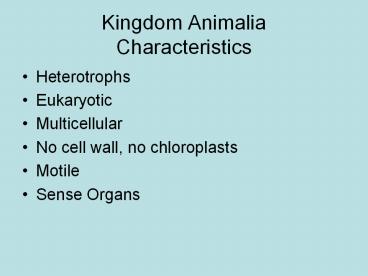Kingdom Animalia Characteristics - PowerPoint PPT Presentation
Title:
Kingdom Animalia Characteristics
Description:
Kingdom Animalia Characteristics Heterotrophs Eukaryotic Multicellular No cell wall, no chloroplasts Motile Sense Organs 9 phyla we will mention Porifera sponges ... – PowerPoint PPT presentation
Number of Views:670
Avg rating:3.0/5.0
Title: Kingdom Animalia Characteristics
1
Kingdom AnimaliaCharacteristics
- Heterotrophs
- Eukaryotic
- Multicellular
- No cell wall, no chloroplasts
- Motile
- Sense Organs
2
9 phyla we will mention
- Poriferasponges
- Cnidariajellyfish, sea anemones, coral
- Platyhelminthesflatworms
- Nematodaroundworms
- Annelidaearthworms
- Molluscashelled animals
- Arthropodainsects, spiders
- Echinodermataspiny-skinned
- Chordatavertebrates (and others)
3
Phylum Porifera(sponges)
- Asymmetrical
- Poresfilter feeders
- Not motile (sessile)
- Provide habitat for other animals
- Eaten by starfish and some fish
- Most primitive animal
4
Phylum Cnidaria(jellyfish, sea anemones, coral)
- Digestive cavity called a coelenteron
- Radial symmetry
- Predators-feed on crustaceans
- Corals provide important habitat for fish
- Coral used for decoration and threatened by
pollution - All have stinging cells
5
Phylum Platyhelminthes(planarians, tapeworms,
flukes)
- Bilateral symmetry
- Cephalization- head and brain
- Acoelomate- no body cavity
- Incomplete digestive system (one opening)
- Some are parasites in digestive tract
- In early 1900s models ate them to be thinYUK!
6
Phylum Nematoda(roundworms)
- Also called nematodes
- Complete digestive system-separate mouth and anus
(2 openings) - Pseudocoelomate
- Decomposers, predators (bacteria, inverts)
- Eaten by insects, mice
- Beneficial to garden by eating insects
7
Phylum Annelida(segmented worms)
- i.e. earthworms, leeches
- True coelom
- Sensitive to vibrations on ground-rain
- Prey for robins, shrews, jays, snakes
- Leeches have cornified knobs to break skin,
anticoagulant and anesthetic
8
Phylum Mollusca(shelledsometimes)
- i.e. snails, slugs, clams, mussels, scallops,
oysters, octopus and squid - Variety in form
- Giant squid sea serpent
- Introduction of garden snails
9
Phylum Arthropoda(jointed legged animals)
- i.e. insects, spiders and scorpions, shellfish
(crustaceans), centipedes (1 pr legs per
segment), millipedes (2 pr) - Exoskeleton
- Metamorphosis
- Pheromones
- Molting
10
Phylum Echinodermata(spiny-skinned)
- i.e. sea stars starfish,
- sea urchins
- Water vascular system
- Tube feet
- Important predators
11
Phylum Chordata(includes the vertebrates)
- i.e. fish, sharks, amphibians, reptiles, birds,
mammals - Notochord, nerve cord, gill slits, tail































